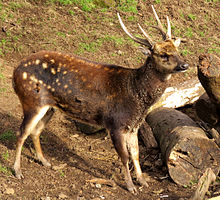
Walden's hornbill locally called dulungan, also known as the Visayan wrinkled hornbill, rufous-headed hornbill or writhe-billed hornbill, is a critically endangered species of hornbill living in the rainforests on the islands of Negros and Panay in the Philippines. It is closely related to the writhed hornbill, but can be recognized by the yellow throat and ocular skin in the male, and the blue throat and ocular skin in the female. Its binomial name commemorates the Scottish ornithologist Viscount Walden.
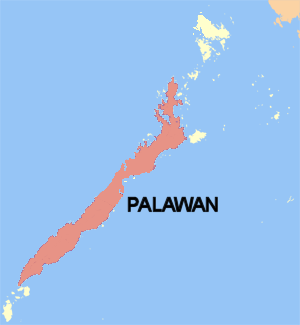
Palawan is the largest island of the province of Palawan in the Philippines and fifth-largest by area and tenth-most populous island of the country, with a total population of 994,101 as of 2020 census. The northwest coast of the island is along the Palawan Passage in the eastern South China Sea, while the southeast coast forms part of the northern limit of the Sulu Sea. Much of the island remains traditional and is considered by some as under-developed. Abundant wildlife, jungle mountains, and some white sandy beaches attract many tourists, as well as international companies looking for development opportunities.

The Negros bleeding-heart pigeon is endemic to the Philippines where it is found on the islands of Negros and Panay. It is critically endangered; continuing rates of forest loss on the two islands where it occurs suggest that it will continue to decline. The population is estimated to be just 50 - 249 mature individuals. The species has an extremely small, severely fragmented population. The bird is listed as an EDGE species under the analysis of the Zoological Society of London.
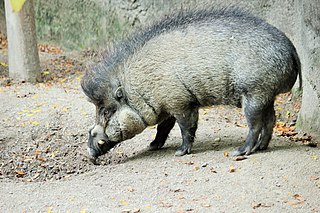
The Visayan warty pig is a critically endangered species in the pig genus (Sus). It is endemic to six of the Visayan Islands in the central Philippines. It is known by many names in the region with most translating into 'wild pig': baboy ilahas, baboy talonon, baboy sulop, and baboy ramo.
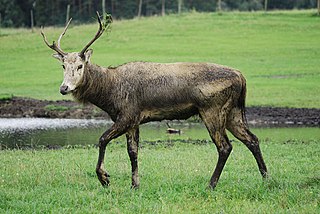
The Cervinae or the Old World deer, are a subfamily of deer. Alternatively, they are known as the plesiometacarpal deer, due to having lost the parts of the second and fifth metacarpal bones closest to the foot, distinct from the telemetacarpal deer of the Capreolinae.

The Philippine deer, also known as the Philippine sambar or Philippine brown deer, is a vulnerable deer species endemic to the Philippines. It was first described from introduced populations in the Mariana Islands, hence the specific name.
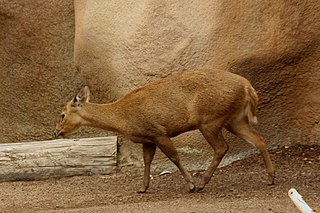
The Calamian deer, also known as Calamian hog deer, is an endangered species of deer found only in the Calamian Islands of Palawan province in the Philippines. It is one of three species of deer native to the Philippines, the other being the Philippine sambar and the Visayan spotted deer.

The black-belted flowerpecker or Visayan flowerpecker, is a species of bird in the family Dicaeidae. It is endemic to the Philippines where it is restricted to Panay, Negros and Guimaras islands. It was formerly regarded as a subspecies of the more widespread red-keeled flowerpecker. Sometimes the name red-keeled flowerpecker is used for D. haematostictum and D. australe is then known as the red-sided flowerpecker.

Mount Talinis is a complex volcano in the Philippine province of Negros Oriental. At about 1,903 metres (6,243 ft) above sea level, it is the second highest mountain on Negros Island after Mount Kanlaon, and the tallest peak in the mountain range known as the Cuernos de Negros. The volcano is located 9 km (5.6 mi) southwest of the municipality of Valencia; and 20 km (12 mi) from Dumaguete, the capital of the province.
The Visayan leopard cat, known locally as maral, is a Sunda leopard cat population in the Philippine Islands of Negros, Cebu and Panay. It has been listed as vulnerable on the IUCN Red List in 2008 under its former scientific name P. bengalensis rabori as its range is estimated to be less than 20,000 km2 (7,700 sq mi), and the population was thought to be decreasing.

The wildlife of the Philippines includes a significant number of endemic plant and animal species. The country's surrounding waters reportedly have the highest level of marine biodiversity in the world. The Philippines is one of the seventeen megadiverse countries and is a global biodiversity hotspot. In 2013, 700 of the country's 52,177 species were listed as threatened.

The Negros scops owl, also known as the Visayan scops owl, is an owl, endemic to the islands of Negros and Panay in the Philippines, belonging to the family of the typical owls Strigidae. It was formerly classified as a subspecies of the Philippine scops owl. It is threatened by habitat loss and hunting for the pet trade.

The yellow-faced flameback is a species of bird in the family Picidae. It is found on the Philippine islands of Negros and Panay. It is extinct on Guimaras, Masbate, and Ticao (extinct). It is one of the most spectacular woodpeckers with its bright yellow head and crimson red back. It is sometimes considered a subspecies of the greater flameback. It is found in moist lowland forests including primary, secondary and even plantations and clearings provided there are still standing trees. It is the rarest woodpecker in the country and it is threatened by habitat loss.
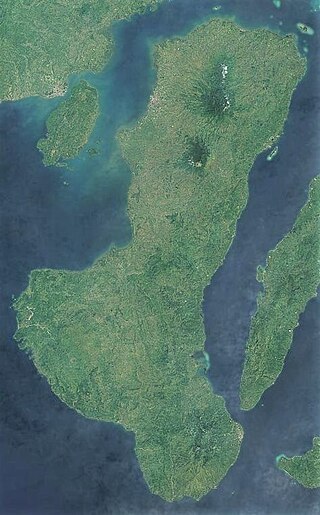
Negros is the fourth largest and third most populous island in the Philippines, with a total land area of 13,309 km2 (5,139 sq mi). Negros is one of the many islands of the Visayas, in the central part of the country. The predominant inhabitants of the island region are mainly called Negrenses. As of 2020 census, the total population of Negros is 4,656,945 people.
The Visayan rhabdornis is a species of bird currently placed in the starling family, Sturnidae. It is endemic to the central Philippines on the islands of Negros and Panay. It was previously considered a subspecies of the stripe-breasted rhabdornis. It lives in tropical moist montane forest and is threatened by habitat loss.

The Northern Negros Natural Park is a protected area of the Philippines located in the northern mountainous forest region of the island of Negros in the Visayas. It is spread over five municipalities and six cities in the province of Negros Occidental and is the province's largest watershed and water source for seventeen municipalities and cities including the Bacolod metropolitan area. The park was established first as a forest reserve spanning 107,727 hectares on 28 April 1935 through Administrative Act No. 789 signed by Governor-General Frank Murphy. On 7 August 1946, the Northern Negros Forest Reserve was reduced to its present area of 80,454.5 hectares with the signing of Proclamation No. 798 by President Manuel Roxas. In 2005, the protected area was converted into a natural park under the National Integrated Protected Areas System (NIPAS) Act by virtue of Proclamation No. 895 signed by President Gloria Arroyo.
Sibalom Natural Park is a 5,511.47-hectare (13,619.1-acre) protected area in the Philippines on the island of Panay in the municipality of Sibalom, Antique. It was proclaimed a natural park on 23 April 2000. It is considered one of the last remaining lowland rainforests on Panay.

Balinsasayao Twin Lakes Natural Park is a natural park in the Philippines surrounding Lake Balinsasayao and Lake Danao in the province of Negros Oriental, 14.5 kilometres (9.0 mi) west of Dumaguete. It covers an area of 8,016.05 hectares, with heights ranging from 830 to 846 metres. The park is located in the Mount Talinis range, also known as Cuernos de Negros, in the southern portion of Negros Island, and spans across the municipalities of Valencia, Sibulan and San Jose. It was declared a protected area in 2000.
The Mari-it Wildlife and Conservation Park is a protected area in Lambunao, Iloilo in the island of Panay in the Philippines. It is managed by the West Visayas State University–College of Agriculture and Forestry (WVSU-CAF). It was also the largest hornbill breeding facility in the world.

The Greater Negros–Panay rain forests ecoregion covers the central Visayan Islands in the Philippines, including the islands of Panay, Negros, Cebu, Masbate, Sibuyan, Ticao, Guimaras, Romblon, Tablas, Siquijor, and Bohol, but excludes Leyte and Samar. During the last ice age, these were all on the same island. The lack of a land bridge to Asia during the ice age kept most Asian megafauna, including elephants and tigers, from reaching the Philippines and the Visayan Islands, which hosts many unique and endemic species with some exclusive only to an island.
